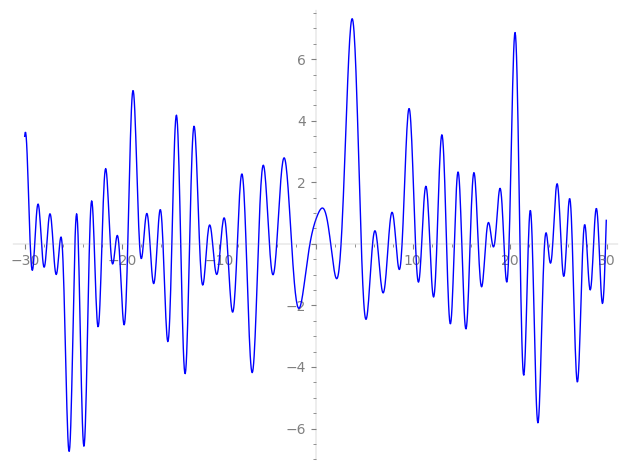| L(s) = 1 | + (−0.866 − 0.5i)2-s + (−0.818 + 1.52i)3-s + (0.499 + 0.866i)4-s + (0.401 − 0.695i)5-s + (1.47 − 0.912i)6-s + (1.69 − 2.03i)7-s − 0.999i·8-s + (−1.65 − 2.49i)9-s + (−0.695 + 0.401i)10-s + (−1.31 + 0.760i)11-s + (−1.73 + 0.0542i)12-s − i·13-s + (−2.48 + 0.913i)14-s + (0.732 + 1.18i)15-s + (−0.5 + 0.866i)16-s + (−2.74 − 4.76i)17-s + ⋯ |
| L(s) = 1 | + (−0.612 − 0.353i)2-s + (−0.472 + 0.881i)3-s + (0.249 + 0.433i)4-s + (0.179 − 0.311i)5-s + (0.600 − 0.372i)6-s + (0.640 − 0.768i)7-s − 0.353i·8-s + (−0.553 − 0.833i)9-s + (−0.219 + 0.126i)10-s + (−0.397 + 0.229i)11-s + (−0.499 + 0.0156i)12-s − 0.277i·13-s + (−0.663 + 0.244i)14-s + (0.189 + 0.305i)15-s + (−0.125 + 0.216i)16-s + (−0.666 − 1.15i)17-s + ⋯ |
\[\begin{aligned}\Lambda(s)=\mathstrut & 546 ^{s/2} \, \Gamma_{\C}(s) \, L(s)\cr =\mathstrut & (0.254 + 0.967i)\, \overline{\Lambda}(2-s) \end{aligned}\]
\[\begin{aligned}\Lambda(s)=\mathstrut & 546 ^{s/2} \, \Gamma_{\C}(s+1/2) \, L(s)\cr =\mathstrut & (0.254 + 0.967i)\, \overline{\Lambda}(1-s) \end{aligned}\]
Particular Values
| \(L(1)\) |
\(\approx\) |
\(0.617101 - 0.475864i\) |
| \(L(\frac12)\) |
\(\approx\) |
\(0.617101 - 0.475864i\) |
| \(L(\frac{3}{2})\) |
|
not available |
| \(L(1)\) |
|
not available |
\(L(s) = \displaystyle \prod_{p} F_p(p^{-s})^{-1} \)
| $p$ | $F_p(T)$ |
|---|
| bad | 2 | \( 1 + (0.866 + 0.5i)T \) |
| 3 | \( 1 + (0.818 - 1.52i)T \) |
| 7 | \( 1 + (-1.69 + 2.03i)T \) |
| 13 | \( 1 + iT \) |
| good | 5 | \( 1 + (-0.401 + 0.695i)T + (-2.5 - 4.33i)T^{2} \) |
| 11 | \( 1 + (1.31 - 0.760i)T + (5.5 - 9.52i)T^{2} \) |
| 17 | \( 1 + (2.74 + 4.76i)T + (-8.5 + 14.7i)T^{2} \) |
| 19 | \( 1 + (0.336 + 0.194i)T + (9.5 + 16.4i)T^{2} \) |
| 23 | \( 1 + (4.51 + 2.60i)T + (11.5 + 19.9i)T^{2} \) |
| 29 | \( 1 + 6.22iT - 29T^{2} \) |
| 31 | \( 1 + (-2.61 + 1.50i)T + (15.5 - 26.8i)T^{2} \) |
| 37 | \( 1 + (-5.08 + 8.81i)T + (-18.5 - 32.0i)T^{2} \) |
| 41 | \( 1 - 1.60T + 41T^{2} \) |
| 43 | \( 1 - 7.00T + 43T^{2} \) |
| 47 | \( 1 + (0.663 - 1.14i)T + (-23.5 - 40.7i)T^{2} \) |
| 53 | \( 1 + (-6.21 + 3.58i)T + (26.5 - 45.8i)T^{2} \) |
| 59 | \( 1 + (0.198 + 0.344i)T + (-29.5 + 51.0i)T^{2} \) |
| 61 | \( 1 + (8.18 + 4.72i)T + (30.5 + 52.8i)T^{2} \) |
| 67 | \( 1 + (0.134 + 0.232i)T + (-33.5 + 58.0i)T^{2} \) |
| 71 | \( 1 - 6.19iT - 71T^{2} \) |
| 73 | \( 1 + (13.1 - 7.60i)T + (36.5 - 63.2i)T^{2} \) |
| 79 | \( 1 + (-5.57 + 9.65i)T + (-39.5 - 68.4i)T^{2} \) |
| 83 | \( 1 - 8.35T + 83T^{2} \) |
| 89 | \( 1 + (7.89 - 13.6i)T + (-44.5 - 77.0i)T^{2} \) |
| 97 | \( 1 - 6.73iT - 97T^{2} \) |
| show more | |
| show less | |
\(L(s) = \displaystyle\prod_p \ \prod_{j=1}^{2} (1 - \alpha_{j,p}\, p^{-s})^{-1}\)
Imaginary part of the first few zeros on the critical line
−10.62668699367744684832364258900, −9.798653322291386171650700979503, −9.122481109275324446789606916135, −8.082810234105472185678672199890, −7.18021268144305143508466899627, −5.90660860371904246394145938172, −4.77548149964595052125677967047, −4.02281434872176124968181613963, −2.48512617675806008201831601315, −0.59884335106040505326085945248,
1.54212226588439745397979020332, 2.61201223078355339990724950425, 4.69278471946506269915464841960, 5.86107974199580742676248671049, 6.36056910894947820758011949264, 7.47674594788298294076455231044, 8.279123711042986038364941279219, 8.900876796073889279721924847694, 10.28498533660175832962054095652, 10.92048923593843943087140879761

